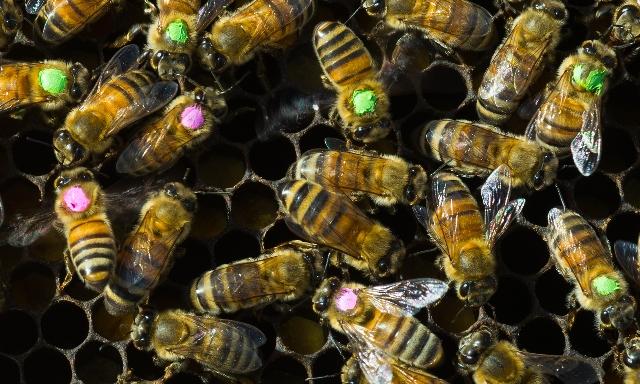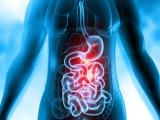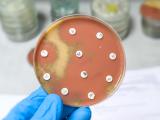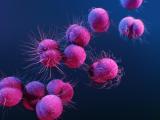Kasie Raymann, PhD, a postdoctoral researcher in evolutionary biology and microbiology at the University of Texas at Austin, loves bees. She's also very interested in the gut microbiome—the population of bacteria and microbes in the gastrointestinal tract—and how it affects human and animal health. Her latest study brings those two interests together.
The purpose of the study, published this week in PLoS Biology, was to examine how antibiotic exposure alters the composition of healthy bacteria in the gastrointestinal tract of honeybees, and the consequences of disrupting the bees' gut microbiota. But the researchers were hoping the study would also provide some clues to how antibiotics can affect normal gut flora in other species, particularly humans.
What antibiotics do to the composition of bacteria in the human body, and the role that gastrointestinal pathogens play in disease, have drawn increasing interest among infectious disease experts. Although the mechanisms aren't completely understood, gut microbiota alterations caused by antibiotics are suspected of paving the way for the development of infectious pathogens like Clostridium difficile, one of the most common causes of hospital-associated diarrhea.
There's also concern that by disrupting the balance of good and bad bacteria in the body, antibiotics can make people more vulnerable to drug-resistant infections.
"Using antibiotics is one way you can disrupt the microbiome and better understand the consequences of having a perturbed microbiome," Raymann, lead author of the study, told CIDRAP News.
A model organism
Honeybees, it turns out, provide a perfect test subject for this research. Like humans, they have specialized gut bacteria that live only in the host gut and aid in digestion. And like humans, they acquire their gut bacteria through social contact. Honeybees are also similar to humans in that they have a long history of exposure to antibiotics. For more than 50 years, beekeepers have treated colonies with antibiotics—mainly tetracycline—to prevent a bacterial disease called foulbrood.
But in honeybees, the composition of gut bacteria is much simpler than in people, consisting mainly of eight core bacterial species. The human gut, by contrast, contains 500 to 1,000 bacterial species. This makes bees a model organism for better understanding how the microbiome functions.
In the study, Raymann and her team collected adult worker bees from a hive at the university and split them into two groups. One group of bees was fed a sweet syrup containing tetracycline for 5 days, while the other group received just the sweet syrup. The bees were then returned to the hive, and Raymann collected samples of gut microbiota every few days over the course of a week and monitored the bees' survival. Colored dots painted on the bees' backs while they were immobilized helped her keep track of which had received antibiotics and which hadn't.
What Raymann and her colleagues found was a clear and significant alteration of the bacterial community in the bees that were treated with tetracycline. "Nearly all of the core [bacterial] species that are always present in the bee microbiome were severely reduced in number, and there were changes in relative abundance of each these species," Raymann explained.
Of the eight core bacterial species normally found in the bee gut microbiome, four were dramatically reduced. Compared with the bees in the control group, the antibiotic-treated bees had five times fewer bacterial cells in their guts.
Opportunistic pathogens
In addition, 3 days after the bees were returned to the hive, only one third of the treated bees remained, compared with two thirds of the control bees. Raymann said the higher mortality among the treated bees correlated with the presence of the opportunistic pathogen Serratia, which isn't normally present in the bee gut microbiome. Although it's unclear where the pathogen came from, Raymann said some of the bees might have acquired it when they left the hive to forage.
To test whether the elevated Serratia might be the cause of higher mortality in the treated bees, Raymann infected a separate group of bees with a strain of the pathogen. She found that bees treated with tetracycline and exposed to Serratia were more likely to die than those just exposed to the pathogen. The way that Serratia grabbed a foothold in the disrupted microbiome of the treated bees, Raymann explains, is similar to what happens in humans when pathogens like C difficile cause infections in patients exposed to antibiotics.
"The opportunistic pathogens are able to infect the bees at a much higher rate after their microbiome has been disrupted," Raymann said. A longer study, she added, could look at whether the bees' gut microbiome eventually recovers to its normal state.
Raymann said her findings suggest antibiotic use in bees could be a contributing factor—one of many—in colony collapse disorder, which has been killing off honeybees in large number in recent years. While she notes that widespread pesticide use and loss of foraging habitat are likely the biggest factors, she thinks antibiotic use is an area that should be explored.
"I do think we should look more into it, and take caution about using antibiotics," she said.
And that caution should extend to humans as well. Raymann believes her study adds to a growing body of research suggesting that antibiotics can disrupt the microbiome and lead to infection and provides another reason to be careful about how we use antibiotics. "Not only can they disrupt your beneficial microbes and lead to some pathogen infection, but the overuse of antibiotic can also lead to antibiotic resistance," she said.
See also:
Mar 14 PLoS Biol study
Mar 14 University of Texas at Austin news release






















